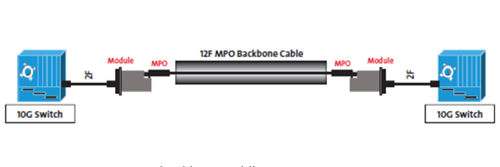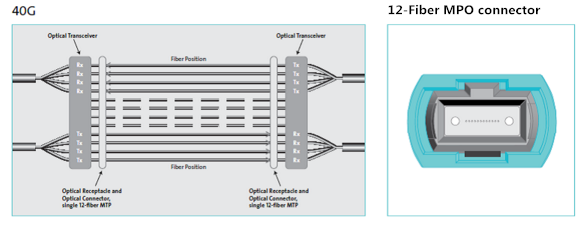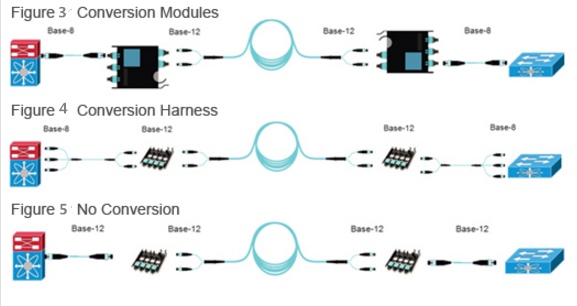Fiber optic links are vital for providing the bandwidth and speed needed to transmit huge amounts of data to and from a large number of sources. Recently more bandwidth is greatly needed to support the use of virtualization and improved space utilization in the data center. 2010 witnessed the ratification of 40 and 100 gigabit Ethernet (GbE) standard, since then leading switch manufacturers offered 40 GbE blades and more than 25% of data centers have implemented these next generation speeds. It is anticipated that by the end of this year, more and more data centers will follow suit. Therefore today’s article will provide an effective solution to help you migrate from current data center applications to 40/100 GbE.
10G OM3/OM4 Connectivity in the Data Center
The IEEE 802.3ae 10G standard released in 2002 included 10GBASE-SR OM3 guidance that can operate at 850nm with duplex fiber serial transmission. Even though duplex fiber implied duplex LC connectivity throughout the channel, 12F MPO terminated cables emerged as a primary choice for deployment in data-center backbone applications. The 12F MPO terminated trunk cable provided the highest fiber packing density to maximize pathway and space utilization in ducts, raceways, and patch panels. For example, 46C3447 is IBM BNT 10GBASE-SR SFP+ that operates over OM3 cable for a distance of 300m with LC duplex connector. An MPO connectorized backbone cable typically is terminated in patch panels using one of two methods that break-out the 12F MPO to six 2F duplex LC (Figure 1).

Standards From 10GbE to 40/100GbE
Similar to how transportation highways are scaled to support increased traffic with multiple lanes at the same speed, the 40 and 100 GbE standards use parallel optics, or multiple lanes of fiber transmitting at the same speed. Running 40 GbE requires 8 fibers, with 4 fibers each transmitting at 10 Gbps and 4 fibers each receiving at 10 Gbps. Running 100 GbE requires a total of 20 fibers, with 10 transmitting at 10 Gbps and 10 receiving at 10 Gbps. Both scenarios call for using high-density multi-fiber MPO style connectors.

According to IEEE 802.3ba standard, multimode optical fiber supports both 40 and 100 GbE over link lengths up to 150 meters when using OM4 optical fiber and up to 100 meters when using OM3 optical fiber. It is important to note that single-mode fiber can also be used for running 40 and 100 GbE to much greater distances using wavelength division multiplexing (WDM) for most data center applications of less than 150 meters. Copper twinax cable is also capable of supporting 40 and 100 GbE but only to distances of 7 meters. Take EX-SFP-10GE-DAC-1M as an example, it is Juniper SFP+ passive copper cable, which is ideal for 10G interconnect application for a link length of 1m.
Migration From Duplex Fiber Transmission to 40/100G Parallel Optics
Based on a MPO system, migration from 10G to 40G to 100G seems to be a simple and easy deployment. Starting with a 10G configuration, a base 12F MPO backbone cable is deployed between the 10G switches. As discussed earlier, modules or harnesses are used at the end to transition from the 12F MPO to LC duplex. These breakout configurations enable connectivity into the switch.

And when the switches migrate to 40G, the 10G module or harness is removed and should be replaced by a conversion module or conversion harness as shown in Figure 3 and Figure 4. Alternatively, an MPO adapter panel can be used. In any of these deployment options, the use of an MPO terminated jumper is needed to establish connectivity between the switches. For 100GBASE-SR4 networks all Figures 4-6 cabling is applicable.
Conclusion
To keep up with the path of future, MPO-based connectivity using OM3 and OM4 is the ideal solution for the data center, which makes the transition to 40/100G more easier and efficient. Fiberstore offers various types of 40GbE transceivers, MPO/MTP trunk cable, MPO/MTP harness cable, MPO/MTP cassette and other assemblies for your 40G network connectivity. For more information about our products, please contact us directly.

Thank you for sharing the information.
ReplyDeletePassive Networking
Structured Cabling
thanks for sharing,good blog..
ReplyDeletestructured cabling companies
structured cabling solutions